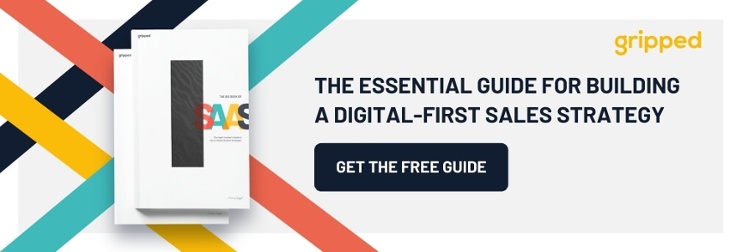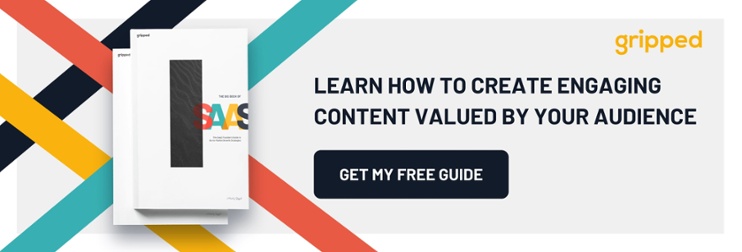Influencing the Digital Age Buyer’s Journey
Share this article

Information in today’s digital milieu has always been a double edged sword for sales and marketing. It works for you if you can control it. Information comes from your sales team, your website and your press releases. Outside that – it’s a free-for-all.
As we all know, the latter is the reality. What we often have to deal with is a highly-evolved B2B buyer, someone who’ve searched across several online platforms. And, according to The Digital Evolution in B2B Marketing, a 2014 research conducted by the Marketing Leadership Council of CEB (now known as Gartner) in partnership with Google, this person will not face a sales rep until 57 percent of their buyer’s journey is done.
So, it pays to ask: How do B2B buyers search for tech solutions and how can you ensure you’re there, at every stage of their buyer’s journey?
B2B Buyer Behavior
There have been several studies on today’s buyer behavior, and one stand-out commonality is that B2B buyers go online first before reaching out to a sales team (if ever they do).
A 2014 research by the Acquity Group, a digital marketing company under Accenture, pegs the number of B2B buyers who do online research at 94 percent. This is further broken down to the top go-to sites. Business websites lead at 84.3 percent; this is followed closely by 77 percent who turn to Google search. Other notable online resources include third party websites (34%), such as blogs and industry websites, and online user reviews (41%).
Analytics Advocate at Google Adam Singer confirms this at a ClickZ Live conference in San Francisco and adds that a person, on average, checks out 10.4 online resources before reaching out to a sales rep.
The Digital Age Buyer’s Journey
The fact that a buyer faces a sales rep only at 57 percent into the journey is perhaps not the most disconcerting finding to come out of these recent B2B buyer studies. It also raises a red flag that a lot of people are looking for a self-service buying experience. 31 percent say they prefer an unassisted online purchase, with phone support only as a just-in-case. Another 10 percent say they want zero assistance; while 12.5 percent say they want to be walked through the purchasing process.
You can’t help but wonder where in the digital age buyer’s journey would the sales team figure in?
According to the CEB study, you only get a 12 percent mindshare (public awareness) for each typical buyer who goes through the buyer’s journey. This share spans across a variety of channels.
The Salesforce’s Pardot survey, 2013 State of Demand Generation Report, claims that 71.7 percent of buyers start with a Google search. This is followed by personal networks at 15.6 percent and social networks at 2 percent.
This brings us to a familiar B2B scenario, typical in today’s buyer’s journey: Say that your company is looking for a CTI solution that integrates your phone systems to your CRM. You get on the project and do an online research. This leads you to a variety of business websites, such as Salesforce and Tenfold. You also look into industry forums to see what your peers have to say about the many vendors in the CTI market. You read blogs, reviews and how-to’s to see if the system suits your requirements and has the flexibility that you need. Through your research, you come up with the top 3 vendors, which you then invite to present and bid.
This might sound like a good deal because a sales-ready buyer comes to you. But, consider too that in no part of their buyer’s journey are you able to influence and educate.
Instead, you function only as an order taker. Your buyer already has a preconceived idea of what you offer. It can be hard to sway them otherwise – unless you can overcome the three main hurdles in B2B marketing and sales: ineffective digital integration, unfocused content and an unoptimized mix of online channels.
Know the Modern B2B Buyer
But first, let’s get to know who the modern B2B buyer is.
The Millennial Influence
Forget what you believe in when it comes to the B2B buyer. He or she isn’t middle-aged and working a managerial or executive position. In fact, the B2B buyer is getting younger!
The Pew Research Center has found that millennials are the biggest generation cluster in the American workforce today. There is more than one millennial in every three employees in the job market. And, they are working closer and closer towards positions of influence, when it comes to B2B purchases.
According to a 2014 survey conducted by Google and research company Millward Brown Digital, millenials make up 46 percent of prospective B2B buyers. This data is up from 2012’s 27 percent, which signifies the growing influence of this generation.
Director of Business and Industrial Markets for Google, Mike Miller, says that this represents a “big shift in a two-year time span.” He believes that this is partly due to the retirement of baby boomers. A new powerhouse generation is emerging in the lead.
This requires rehashing old B2B marketing strategies that usually target senior-level executives. While millennials may still not hold positions of power, their influence is clear. They make up 24 percent of non-executives tasked to help in B2B purchasing decisions. This is a generation who grew up at a time when mobile phones and the internet were readily available. You can be sure they will use these access and mobility tools in B2B research and recommendations.
The Multiple-Channel B2B Buyer
The multiple-channel buyer is always connected and researching online through mobile phones, tablets and desktops. They have mobility and access. They read your websites, reviews and blogs; and might have even downloaded one of your demos. They attend conferences and seminars – sometimes online – to learn about industry breakthroughs and innovations. They can cover multiple channels partly because they’ve fully integrated mobility and the internet into their lives.
According to the Google/ Millward Brown Digital study, by 2014, 34 percent of those involved in B2B purchasing decisions use their mobile devices at each stage of their buyer’s journey. This is almost twice the devoted mobile users/ B2B buyers of 2012. Mobile phone usage extends to work places and social gatherings; and includes requests for bids, product comparisons, video viewing and contacting the vendor.
The increase in video viewing is another metric attributed to the multiple-channel buyer. According to YouTube, more than 895,000 hours of videos viewed are those by top B2B brands. In fact, 70 percent of those surveyed by Google say they use videos to learn more about products before making a purchase.
Information Overload
The availability of seemingly limitless information empowers the new B2B buyer. And because they access content at each step of their buyer’s journey, you too must be on this content train.
According to the Content Marketing Institute and MarketingProfs’s 2016 Benchmarks, Budgets and Trends – North America, 88 percent of marketers implement content marketing strategies. 76 percent of these say that they will include content marketing allocation by 2015. On average, 28 percent of the marketing budget go to content marketing. However, those who are most effective at it spend around 42 percent.
So, remember that the modern B2B buyer is swimming in a sea information. Your share shouldn’t just be a forgettable drop.
Influencing the Digital Age Buyer’s Journey
Perhaps there are several strategies you can study and implement in order to influence the new B2B buyer. However, at the core of it will always be the actions you take in dealing with modern B2B marketing and sales’ main hurdles: digital integration, content and channel mix.
Comprehensive Digital Integration
Your effective presence online should cease being treated like an annoying fly buzzing and tweeting about. Traditional marketing campaigns have been rendered obsolete by B2B buyers who are empowered with information. Their product learning can’t coincide with your campaign plans because they go about it on their own, online.
Here are a few steps to take to start a comprehensive digital integration program, according to the Marketing Leadership Council of CEB:
1.Document existing campaign architectures. Make sure to take note of effective strategies and their output.
2.Review marketing practices to see what works and what doesn’t. A dialogue with the sales and marketing team is necessary to get to the real score regarding these practices.
3. Observe and analyze external practices that have worked to get you closer to your goals.
4. Select, codify and implement best practices.
5. Recreate the campaign architecture and refine practices that don’t work as expected.
6. Repeat the process until you reach your ideal.
7. Put together an implementation guideline, as well as an accessible resource center for the guidelines, necessary tools and other information regarding your digital integration.
Purposeful and Focused Content
Many B2B marketers have taken on content marketing like it was the latest must-have trend. This has resulted in content that’s highly unorganized and lacks a consistent and purposeful message. You then get a whole slew of problems, such as prospective buyers swimming in a sea of useless information. This type of information does not really teach them well; and, it does not engage them enough to take the next step in their buyer’s journey with you.
There are several realities that might have factored into this situation. For instance, your web team may have been focused on ranking your website in search results, without being consistent and driving your true message. You might have outsourced your social media management, without providing guidelines on your corporate messaging.
It is important to rectify this, as soon as possible, because your customer engagement is centered on your content. It comes in at all stages of the buyer’s journey. It is at the core of your lead nurturing programs, and online and social media engagements. And, it is everyone’s responsibility – not just your copywriter’s.
This is where the so-called “coverage orientation” comes in. B2B marketers pinpoint topics that interest your target audience, and ensure that you consistently offer fresh content for each topic, through content development and curation. This can be a fruitful content marketing strategy, as long as you have a good understanding of your customers.
Make sure that you cover all your customers’ information requirements. This way, even as they learn about your product on their own, the information that they get still aligns with what you truly offer.
Smart, Targeted Channel Mix
Given several online channels, where should you invest in? Which channels will bring the most qualified leads? Should you invest in creating YouTube videos or simply blogging? Does your target audience need whitepapers or an online archive of manuals, issue reports and resolutions?
There are many ways to develop a targeted channel mix. However, the first step is to recognize your traditionally fragmented approach. The marketing team might be taking care of blogs and other creative text content. Your tech team might have been tasked with putting together your FAQs, whitepapers and other support pages. You might have outsourced your video production to an ad company, and your social media management to an SMM company.
However you’re doing it right now, it is important to account for your efforts, and assess your channel effectiveness. The metrics to use here are often readily available with the team tasked with each channel assignment.
Then, invest more in an expert analytics professional, someone who can accurately assess your channel efforts and audience response. Use your findings to put together a model channel mix, one that suits your target market and gets your messaging right.
Originally posted by Chase Davis – CX Consultant https://www.tenfold.com/sales/how-do-b2b-buyers-search-for-tech-solutions
Reach Your Revenue Goals. Grow MRR with Gripped.
Discover how Gripped can help drive more trial sign-ups, secure quality demos with decision makers and maximise your marketing budget.
Here's what you'll get:
- Helpful advice and guidance
- No sales pitches or nonsense
- No obligations or commitments



Book your free digital marketing review
Other Articles you maybe interested in
B2B Demand Generation: Should You Adopt This Strategy in 2025?
Discover the essential tactics and strategies for B2B demand generation in this comprehensive guide.
A Guide to the Top 10 Marketing Agencies for B2B SaaS Companies: A Comprehensive Comparison Guide
The B2B SaaS landscape is booming—and it’s never been more challenging to break through the noise. Between new entrants, accelerating product cycles, and sky-high expectations from digitally savvy buyers, marketing your SaaS offering effectively requires a nuanced, tech-first approach. That’s where specialised marketing agencies for B2B SaaS companies come in. Unlike generalist agencies, these specialised…
The 10 Best Full Service Digital Marketing Agencies Updated for 2025 (UK List)
Navigating the digital marketing landscape has never been more complex—especially if you’re a B2B tech or SaaS company aiming to stand out in an increasingly crowded space. Between SEO, content marketing, paid campaigns, CRO, marketing automation, and social media engagement, the sheer volume of channels can be overwhelming. That’s where a full-service digital marketing agency…



